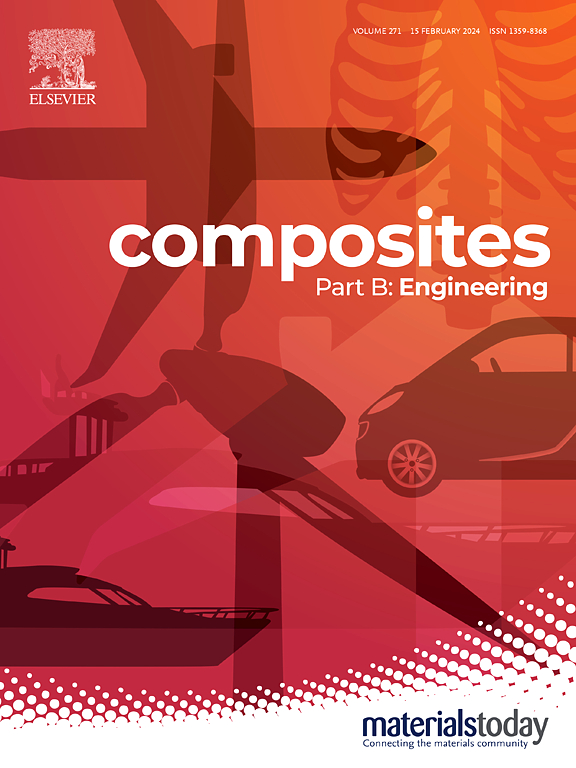Porous and lightweight continuous SiC fiber reinforced Si3N4–SiC composites for wide frequency electromagnetic wave absorption
IF 12.7
1区 材料科学
Q1 ENGINEERING, MULTIDISCIPLINARY
引用次数: 0
Abstract
To cope with the increasing trend of heat flow and electromagnetic radiation generated by high-power electronic devices, it is urgent to develop electromagnetic wave absorbing (EMA) materials with both high-temperature resistance and a certain stiffness. In this work, a ceramic matrix composite is constructed with SiC fibers as the reinforcement and electromagnetic loss phase, which presents a considerable effective absorption bandwidth (EAB) of 8.78 GHz (9.20–17.98 GHz) at a thickness of 2.8 mm. The excellent electromagnetic wave (EMW) absorption performance can be attributed to the design of a porous and multiphase ceramic matrix, including the high EMW-lossy amorphous SiC phase and high EMW-transmittance Si3N4 phase. The constructed multi-phase structure can realize an ideal impedance matching, while also ensuring high loss capacity. Moreover, the SiCf/Si3N4–SiC composites retain a discrete pore structure in the matrix, which not only optimizes the dielectric characteristics, but endows the lightweight structure of 1.95 g cm−3. Despite this, the composites present a bending strength of 92.38 MPa. The porous SiCf/Si3N4–SiC composites designed in this work take into account the lightweight structure, high strength, and wide absorption bandwidth, which provide a new design routine for the functional design of ceramic matrix composites.
多孔轻质连续SiC纤维增强Si3N4-SiC复合材料用于宽频电磁波吸收
为了应对大功率电子器件产生的热流和电磁辐射日益增加的趋势,迫切需要开发既耐高温又具有一定刚度的电磁波吸收材料。本文以SiC纤维为增强相和电磁损耗相构建了一种陶瓷基复合材料,该材料在厚度为2.8 mm时具有8.78 GHz (9.20-17.98 GHz)的有效吸收带宽(EAB)。优异的电磁波吸收性能可归因于多孔多相陶瓷基体的设计,包括高EMW损耗的非晶SiC相和高EMW透射率的Si3N4相。所构建的多相结构可以实现理想的阻抗匹配,同时保证高损耗容量。此外,SiCf/ Si3N4-SiC复合材料在基体中保留了离散的孔隙结构,这不仅优化了介电特性,而且赋予了1.95 g cm−3的轻质结构。尽管如此,复合材料的抗弯强度为92.38 MPa。本文设计的多孔SiCf/ Si3N4-SiC复合材料具有结构轻、强度高、吸收带宽宽等特点,为陶瓷基复合材料的功能设计提供了新的设计思路。
本文章由计算机程序翻译,如有差异,请以英文原文为准。
求助全文
约1分钟内获得全文
求助全文
来源期刊

Composites Part B: Engineering
工程技术-材料科学:复合
CiteScore
24.40
自引率
11.50%
发文量
784
审稿时长
21 days
期刊介绍:
Composites Part B: Engineering is a journal that publishes impactful research of high quality on composite materials. This research is supported by fundamental mechanics and materials science and engineering approaches. The targeted research can cover a wide range of length scales, ranging from nano to micro and meso, and even to the full product and structure level. The journal specifically focuses on engineering applications that involve high performance composites. These applications can range from low volume and high cost to high volume and low cost composite development.
The main goal of the journal is to provide a platform for the prompt publication of original and high quality research. The emphasis is on design, development, modeling, validation, and manufacturing of engineering details and concepts. The journal welcomes both basic research papers and proposals for review articles. Authors are encouraged to address challenges across various application areas. These areas include, but are not limited to, aerospace, automotive, and other surface transportation. The journal also covers energy-related applications, with a focus on renewable energy. Other application areas include infrastructure, off-shore and maritime projects, health care technology, and recreational products.
 求助内容:
求助内容: 应助结果提醒方式:
应助结果提醒方式:


